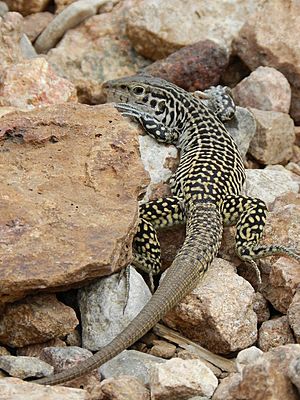Common checkered whiptail facts for kids
Quick facts for kids Common checkered whiptail |
|
|---|---|
 |
|
| Conservation status | |
| Scientific classification | |
| Genus: |
Aspidoscelis
|
| Species: |
tesselatus
|
| Synonyms | |
|
|
The checkered whiptail (Aspidoscelis tesselatus) is a type of lizard. You can find it in the southwestern United States and northern Mexico. It lives in states like Colorado, Texas, and New Mexico. In Mexico, it's found in Chihuahua and Coahuila.
This lizard is special because it can reproduce all by itself. This process is called parthenogenesis. It means the females can lay eggs that hatch without needing a male. Sometimes, people call it the common checkered whiptail. This helps tell it apart from other lizards with similar names.
What Does It Look Like?
The checkered whiptail is a small lizard. It usually grows to about 4 inches long. Its body has many different patterns and colors. You might see brown or black spots, checks, or stripes. These patterns are usually on a light yellow or white background.
Its back legs often have dark spots. The underside of its body is typically white. You might also see dark specks on its throat. This lizard has a slender body and a very long tail.
How Does It Behave?
The checkered whiptail is active during the day. This means it is a diurnal animal. It mostly eats insects, so it is an insectivorous lizard. These lizards are very quick and energetic. If you get too close, they will dart away to find cover.
They like to live in dry, rocky places. You can often find them in canyons or hilly areas. As mentioned, the checkered whiptail reproduces through parthenogenesis. A female can lay up to eight eggs in the middle of summer. These eggs hatch in about six to eight weeks.
Images for kids
-
Checkered whiptail (Aspidoscelis tesselata) in Sierra County, New Mexico



